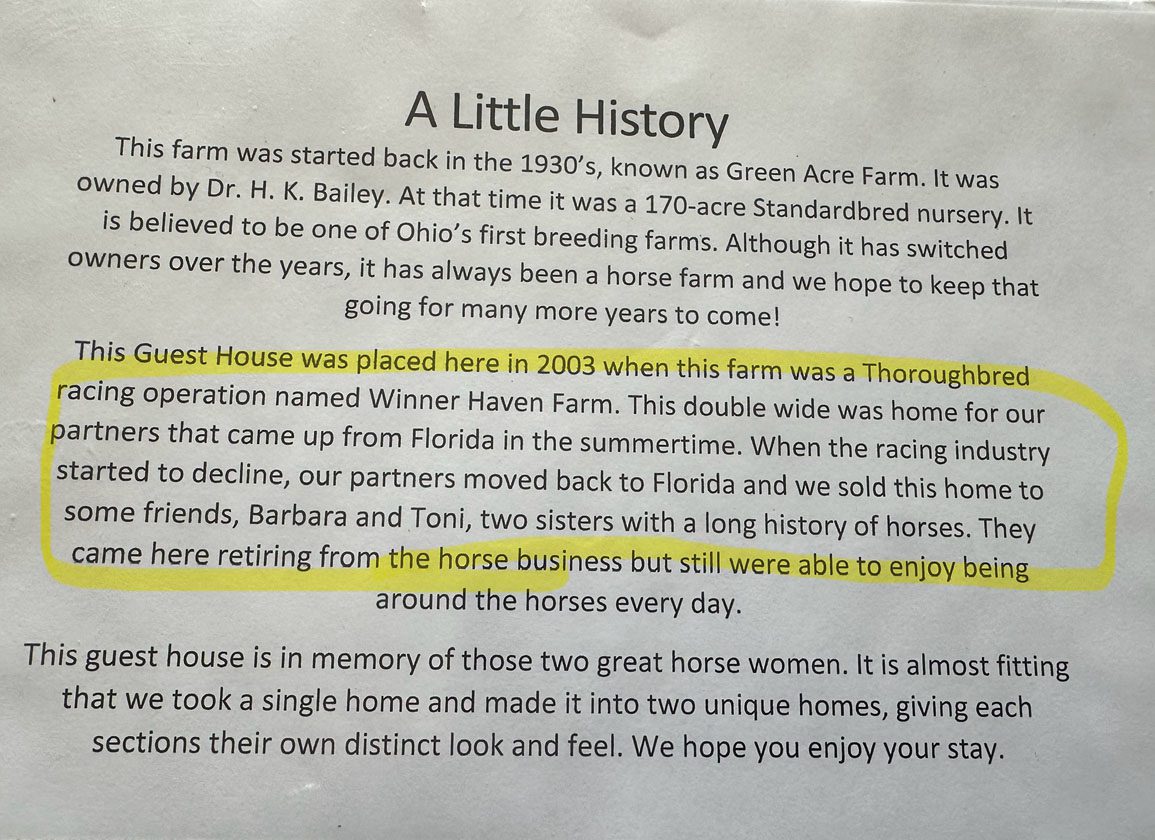So I think this kind of sums up our industry, this attached photo. This weekend my daughter and I went to show her warmblood at WEC Ohio. It was a very successful weekend and we were lucky enough to stay at an Air BnB on a horse farm.
They had a book there with the check-in instructions and the history of the horse farm. I was reading the history of it, and I just wanted to share what to them is insignificant as just facts, but to me, it just hit me on the head as the truths we all need to face.
The show hunter world my daughter is riding in is absolutely booming… I mean it is much more popular now than when I was a kid growing up and showing my ponies. All of the stalls here are full and there are tons and tons of horse-loving people spending gazillion dollars to get zero return on their investments, other than their daughter or son's happiness.
It is going to be through the leadership in the horse racing world to change the trajectory that has been the same for us since I was a child at my parents Thoroughbred farm in Ocala in the 1980s. Funny as I remember the mixed sale catalogs there literally being three books and six days long in Florida.
I am no longer encouraging my daughter who wants to be a Grand Prix rider to eventually shift over to the Thoroughbreds.
Sadly, I have come to the realization that barring major change and intervention, there will be nothing left of our industry. By the time she is my age. (I am 51 she is 17)
Do you know the funny thing is about it all… We both have the most amazing draw and special thing to our industry… the HORSE!!!
But as one industry thrives the other dies.
Until it is about the sport and the horse like it is here in the show jumping world, my life, and the majority of people that I deal with in the Thoroughbred world will continue to contract in their businesses and farms…. As it is now, it is very hard for anything but the professionals to stand and be successful.
I mean, I know the expenses are all rising, as for labor, feed, hay, etc., all of the essentials, but this is the same here in the show world, so what have we done so horribly wrong? That they have done so horribly right?
To figure that out, and to move forward away from the horrendous go baby go campaigns and thought process that no longer appeals to our modern-day society… Then we might have a chance.
There is no person on the planet that wants the Thoroughbreds and our industry to thrive and succeed more in their heart than me. I know that there are many of us, but historically most of us have not had any voice and no seat at the table where it really counts.
The table settings just keep getting smaller and smaller and instead of baking more pies, we're all just fighting over the existing slices.
I don't have all the answers, but I certainly know that there are answers out there. There has to be the willingness to implement them in a unified voice in the current “leadership,” which is not easy in anything we do. I am certainly optimistic that maybe things will change with the new program of light up racing.
The first meeting is this Monday afternoon and I certainly hope that anyone that cares like I do will be there. I want there to be something left for my children to be proud of.
Sincerely,
Carrie Brogden, Machmer Hall
The post Letter to the Editor: Carrie Brogden appeared first on TDN | Thoroughbred Daily News | Horse Racing News, Results and Video | Thoroughbred Breeding and Auctions.

